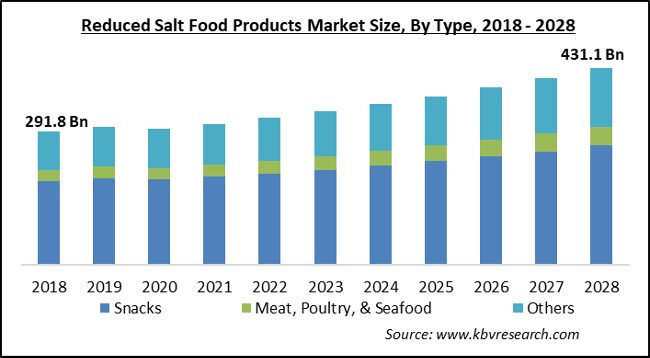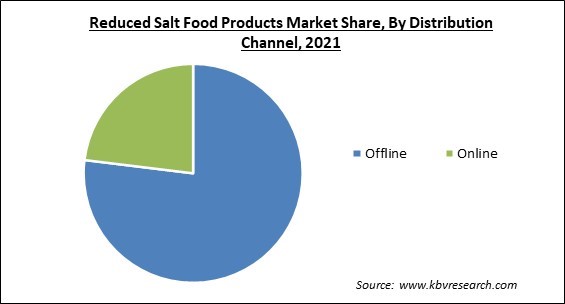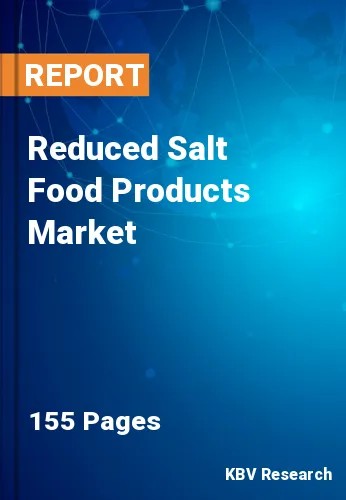The Global Reduced Salt Food Products Market size is expected to reach $431.1 billion by 2028, rising at a market growth of 5.0% CAGR during the forecast period.
Foods with fewer than 120 mg of sodium per 100 grams are referred to as reduced salt food products. The amount of sodium in reduced salts is nearly equivalent to 25% of the sodium in regular salt. Various varieties of meat, vegetables, fish, fruits, nuts, and instant food products, like soups, ready-to-eat meals, biscuits, chips, etc. are preserved using reduced salts. Sodium is a vital mineral that helps the body with a number of crucial processes.

It is naturally present in foods like vegetables and eggs, as well as being a significant part of table salt (sodium chloride). Despite being essential to health, dietary salt can occasionally be limited depending on the situation. For instance, individuals with specific medical disorders, such as high blood pressure, heart failure, and kidney disease, are frequently advised to adhere to a low-sodium diet. Most things people eat include sodium, though entire meals, like fruits, vegetables, and poultry have far lower quantities. Fresh fruit and other plant-based foods typically contain less sodium than animal-based meals, including meat and dairy.
The items that are processed and packed, such as chips, frozen dinners, and fast food, contain the highest concentrations of sodium because salt is added during processing to improve flavor. Adding salt to food while cooking and as a condiment before eating is a significant contribution to sodium intake. Numerous activities aimed at reducing sodium content are being carried out by various governments, and they are predicted to offer the industry's players prospects for expansion. In addition, manufacturers' increased use of salt substitutes and salt reduction technology is expected to create lucrative business prospects for the sector in the coming years.
The COVID-19 pandemic major damaged the economy of a number of countries all over the world. In addition, numerous businesses, irrespective of their sizes, were demolished. Lockdown imposed by a number of governments all over the world led various companies as well as manufacturing facilities to a temporary closure. The reduced salt food products market was also impacted due to the closure of manufacturing facilities. The economic slowdown brought by the COVID-19 outbreak significantly lowered people's earnings and increased their propensity to choose less expensive goods.
With the rapid spread of modernization all over the world, people are becoming more concerned about their lifestyle as well as health. A higher risk of stroke, osteoporosis, stomach cancer, heart failure, and kidney illness is associated with higher salt or sodium intake. As a result, rising consumer awareness of the negative effects of high sodium intake as well as a growing desire for nutrient-dense, healthier food products is driving the reduced salt food products market. Thus, the market size is anticipated to develop significantly in the coming years as a result of rising consumer health problems as well as increased consumption of nutritive and nutritious food products.
Due to a number of health hazards that can be caused by the excess intake of salt in the diet, governments are increasing their focus on spreading more awareness among people to reduce their salt intake. Initiatives to reduce sodium in food may take the form of mandatory or optional governmental targets, corporate initiatives, or health-focused recommendations from various major groups, like the World Health Organization. As the emphasis on nutrition increases in the coming years, it is also anticipated that these sodium guidelines would become more and more crucial and relevant.
Hyponatremia, which results from low blood sodium levels, causes symptoms like weariness, disorientation, and lethargy. The most typical electrolyte issue is hyponatremia. When the level of sodium in the blood is abnormally low, people usually suffer hyponatremia. As an electrolyte, sodium aids in controlling the volume of water in as well as around the cells. When a patient has hyponatremia, their body's sodium levels are diluted for one or more reasons, such as an underlying medical condition or drinking too much water. The body's water content increases as a result, and its cells start to inflate.
On the basis of Product Type, the Reduced Salt Food Products Market is segregated into Snacks, Meat, Poultry, & Seafood, and Others. In 2021, the other segment garnered a significant revenue share of the reduced salt food products market. The rise in customer demand for Ready-To-Eat meals can be ascribed to the significant expansion of this segment. Moreover, the growth of the segment is also being driven by a variety of factors including frantic lifestyles, an increase in the number of people working, and rising per capita spending.

By Distribution Channel, the Reduced Salt Food Products Market is bifurcated into Offline and Online. In 2021, the offline segment procured the highest revenue share of the reduced salt food products market. The rising growth of the segment is a result of an increase in product sales via various offline channels since they offer a distinctive shopping experience. Additionally, offline channels make it possible to physically inspect products and give a variety of promotional incentives, which helps this segment generate revenue.
| Report Attribute | Details |
|---|---|
| Market size value in 2021 | USD 308.8 Billion |
| Market size forecast in 2028 | USD 431.1 Billion |
| Base Year | 2021 |
| Historical Period | 2018 to 2020 |
| Forecast Period | 2022 to 2028 |
| Revenue Growth Rate | CAGR of 5% from 2022 to 2028 |
| Number of Pages | 155 |
| Number of Tables | 250 |
| Report coverage | Market Trends, Revenue Estimation and Forecast, Segmentation Analysis, Regional and Country Breakdown, Companies Strategic Developments, Company Profiling |
| Segments covered | Type, Distribution Channel, Region |
| Country scope | US, Canada, Mexico, Germany, UK, France, Russia, Spain, Italy, China, Japan, India, South Korea, Singapore, Malaysia, Brazil, Argentina, UAE, Saudi Arabia, South Africa, Nigeria |
| Growth Drivers |
|
| Restraints |
|
Region-Wise, the Reduced Salt Food Products Market is analyzed across North America, Europe, Asia-Pacific, and LAMEA. In 2021, Asia Pacific recorded the biggest revenue share of the reduced salt food products market. Increased health concerns among the region's target demographic are ascribed to the region's dominance and growth. These health problems result from bad diet and lifestyle choices, which raise the need for low-sodium goods. Additionally, the region's market expansion is anticipated to be fueled by rising disposable income levels and an increased focus on health.
Free Valuable Insights: Global Reduced Salt Food Products Market size to reach USD 431.1 Billion by 2028
The market research report covers the analysis of key stake holders of the market. Key companies profiled in the report include General Mills, Inc., Nestle S.A., PepsiCo, Inc., The Kraft Heinz Company, Hormel Foods Corporation, Maple leaf foods, Inc., Tyson Foods, Inc., Conagra Brands, Inc., Kellogg Company, Smithfield Foods, Inc.
By Type
By Distribution Channel
By Geography
The global Reduced Salt Food Products Market size is expected to reach $431.1 billion by 2028.
Increased Health Consciousness throughout Customers Along With the Broad Availability Of Products are driving the market in coming years, however, High Risk of Hyponatremia restraints the growth of the market.
General Mills, Inc., Nestle S.A., PepsiCo, Inc., The Kraft Heinz Company, Hormel Foods Corporation, Maple leaf foods, Inc., Tyson Foods, Inc., Conagra Brands, Inc., Kellogg Company, Smithfield Foods, Inc.
The expected CAGR of the Reduced Salt Food Products Market is 5.0% from 2022 to 2028.
The Snacks market is leading the Global Reduced Salt Food Products Market by Type in 2021; thereby, achieving a market value of $261 billion by 2028.
The Asia Pacific market dominated the Global Reduced Salt Food Products Market by Region in 2021; thereby, achieving a market value of $168.5 billion by 2028.
Our team of dedicated experts can provide you with attractive expansion opportunities for your business.

